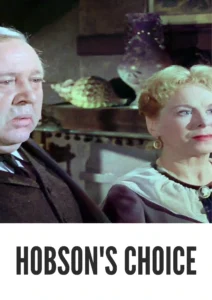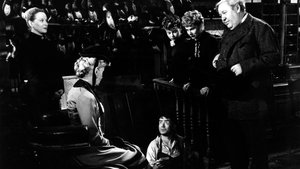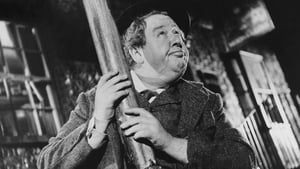Contact: [email protected]
Video Sources 0 Views
- Watch trailer
- Hobson's Choice


Synopsis
Table of Contents
ToggleReview: Hobson’s Choice 1954 – A Timeless Tale of Triumph and Tenacity

Introduction
In the vast landscape of classic cinema, few films possess the enduring charm and timeless appeal of Hobson’s Choice 1954. Directed by David Lean and based on the play by Harold Brighouse, this heartwarming tale of love, ambition, and resilience has captured the hearts of audiences for generations. Now, with the release of its early colored version, viewers have the opportunity to experience this beloved classic in a whole new light. In this review, we will delve into the impact of colorization on the viewing experience of Hobson’s Choice 1954 and its enduring significance in the world of cinema.
Check The Full Colorized Movies List
Check Our Colorized Movies Trailer Channel
Understanding Hobson’s Choice 1954: Director, Cast, and Genre
David Lean’s vision for Hobson’s Choice 1954 was one of authenticity and emotional depth. With a stellar cast including Charles Laughton, John Mills, and Brenda De Banzie, Lean brought the bustling streets of Salford to life with remarkable precision. Hobson’s Choice 1954 defies easy categorization, seamlessly blending elements of comedy, drama, and romance to create a cinematic experience that resonates with audiences of all ages.
Exploring the World of Hobson’s Choice 1954: Plot and Characters
Set in 19th-century England, Hobson’s Choice 1954 tells the story of Henry Hobson, a cantankerous bootmaker who rules over his shop and family with an iron fist. When his eldest daughter Maggie decides to strike out on her own and open a rival shoe emporium, she sets in motion a chain of events that will forever alter the course of their lives. As Maggie navigates the challenges of entrepreneurship and romance, she emerges as a force to be reckoned with, challenging societal norms and redefining the meaning of success on her own terms.
The Art of Film Colorization
Film colorization is a process that has undergone significant evolution since its inception, allowing filmmakers to breathe new life into classic black and white films. By adding color to these timeless works, colorization aims to enhance the visual experience for modern audiences while preserving the integrity of the original film. From hand-tinted frames to advanced digital techniques, colorization has become an essential tool in the preservation and restoration of classic cinema.
Early Colored Films: A Brief History
The history of early colored films is a fascinating journey through the evolution of cinema. From the vibrant hues of Technicolor to the subtle tones of early digital colorization, filmmakers have continually sought to push the boundaries of visual storytelling and capture the imagination of audiences around the world. While early attempts at colorization were often crude and rudimentary, advancements in technology have allowed filmmakers to achieve increasingly lifelike results, paving the way for a new era of color cinema.
Hobson’s Choice 1954 and Its Early Colored Version
The decision to release Hobson’s Choice 1954 in a colorized format was met with both excitement and skepticism. While purists argued for the preservation of the film’s original black and white presentation, others welcomed the opportunity to experience Lean’s masterpiece in vibrant color. Ultimately, the early colored version of Hobson’s Choice 1954 offers viewers a fresh perspective on the film’s timeless themes and memorable performances, inviting them to rediscover this cinematic gem in a whole new light.
The Debate Over Film Colorization
The debate over film colorization is a complex and contentious one, with passionate arguments on both sides of the issue. Proponents of colorization argue that it breathes new life into classic films, making them more accessible to modern audiences and preserving them for future generations. However, detractors worry that colorization can compromise the artistic integrity of the original film, altering the director’s intended vision and detracting from the viewing experience. Ultimately, the decision to colorize a film rests on the filmmaker’s vision and the audience’s reception.
Examining Hobson’s Choice 1954 as an Early Colored Film
As an early colored film, Hobson’s Choice 1954 offers a unique opportunity to explore the intersection of technology and artistry. While some may argue that colorization detracts from the film’s original aesthetic, others contend that it enhances the viewing experience, bringing new depth and dimension to Lean’s masterful storytelling. Indeed, the early colored version of Hobson’s Choice 1954 adds an extra layer of richness and complexity to the film’s evocative visuals, allowing audiences to see familiar scenes in a whole new light.
Influence and Legacy: Hobson’s Choice 1954’s Impact on Cinema
Hobson’s Choice 1954 has left an indelible mark on the world of cinema, inspiring generations of filmmakers and setting the standard for timeless storytelling. Lean’s expert direction and the stellar performances of the cast have cemented the film’s status as a classic of British cinema. Notably, Hobson’s Choice 1954 paved the way for a new era of British filmmaking, influencing filmmakers such as Mike Leigh and Ken Loach and shaping the landscape of British cinema for decades to come.
Director’s Cinematic Legacy: Beyond Hobson’s Choice 1954
David Lean’s cinematic legacy extends far beyond Hobson’s Choice 1954, encompassing a diverse range of films that have left an indelible mark on the world of cinema. From sweeping epics such as Lawrence of Arabia to intimate character studies like Brief Encounter, Lean’s films are united by their emotional depth, visual splendor, and timeless appeal. His influence on local and international filmmaking is undeniable, and his legacy continues to inspire filmmakers around the world.
Themes Explored in Hobson’s Choice 1954
Hobson’s Choice 1954 explores a myriad of themes, from the power of love and ambition to the limitations of class and gender roles. Through its richly drawn characters and intricately woven plot, the film invites audiences to ponder questions of independence, resilience, and the pursuit of happiness. Lean’s masterful direction and the nuanced performances of the cast serve to underscore the film’s themes, creating a poignant and thought-provoking cinematic experience.
Reception and Controversy Surrounding Hobson’s Choice 1954
Upon its release, Hobson’s Choice 1954 received widespread critical acclaim for its engaging storyline, sharp wit, and memorable performances. However, the decision to release the film in a colorized format sparked debate among cinephiles, with some praising the enhanced visual experience while others expressed concern about the potential loss of the film’s original aesthetic. Despite the controversy, Hobson’s Choice 1954 remains a beloved classic that continues to resonate with audiences around the world.
Where to Watch Hobson’s Choice 1954 Online
For those eager to experience the magic of Hobson’s Choice 1954, the film is available for streaming on popular platforms such as Amazon Prime Video and Google Play Movies. Whether viewed in its original black and white format or its early colored incarnation, Hobson’s Choice 1954 promises to captivate and enchant audiences with its timeless tale of triumph and tenacity.
FAQs About Hobson’s Choice 1954
- Is Hobson’s Choice 1954 based on a true story? No, Hobson’s Choice 1954 is a work of fiction adapted from the play of the same name by Harold Brighouse. While the story is set in 19th-century England and depicts the social norms and struggles of the time, the characters and events are purely fictional. However, the portrayal of societal class divisions and the struggle for independence resonates with historical themes prevalent during that era.
- Who are the main actors in Hobson’s Choice 1954? Hobson’s Choice 1954 boasts a talented cast led by Charles Laughton, who portrays the cantankerous bootmaker Henry Hobson with his trademark charisma and depth. John Mills delivers a standout performance as Will Mossop, the humble cobbler who finds his voice and independence under Maggie’s guidance. Brenda De Banzie shines as Maggie Hobson, Henry’s spirited daughter who defies convention to pursue her dreams of love and success. Together, their performances bring the characters to life and imbue the film with richness and authenticity.
- What is the significance of the film’s early colored version? The early colored version of Hobson’s Choice 1954 offers viewers a fresh perspective on the film’s timeless themes and memorable performances. By adding color to the film’s evocative visuals, the early colored version enhances the viewing experience, inviting audiences to rediscover this cinematic gem in a whole new light. The vibrant hues breathe new life into the bustling streets of Salford and highlight the rich tapestry of emotions woven throughout the story, from the warmth of budding romance to the simmering tensions of familial strife.
- How does Hobson’s Choice 1954 compare to other films of its time? Hobson’s Choice 1954 stands out among its contemporaries for its engaging storyline, sharp wit, and memorable characters. While other films of the era may have focused on grand spectacle or sweeping melodrama, Hobson’s Choice 1954 distinguishes itself with its intimate portrayal of everyday life and the universal struggles of its characters. Director David Lean’s meticulous attention to detail and the stellar performances of the cast elevate the film beyond the confines of its period setting, making it a timeless classic that continues to resonate with audiences today.
- What impact did Hobson’s Choice 1954 have on the world of cinema? Hobson’s Choice 1954 left an indelible mark on the world of cinema, inspiring generations of filmmakers and setting the standard for timeless storytelling. Director David Lean’s expert direction and the nuanced performances of the cast have cemented the film’s status as a classic of British cinema. Notably, Hobson’s Choice 1954 paved the way for a new era of British filmmaking, influencing filmmakers such as Mike Leigh and Ken Loach and shaping the landscape of British cinema for decades to come. Its enduring legacy serves as a testament to the power of storytelling to transcend time and culture, resonating with audiences around the world for generations.
Conclusion
Hobson’s Choice 1954 is a timeless classic that continues to captivate and enchant audiences with its engaging storyline, memorable characters, and expert direction. Whether experienced in its original black and white format or its early colored incarnation, the film remains a testament to the enduring power of cinema to entertain, inspire, and provoke thought. As we reflect on the legacy of Hobson’s Choice 1954 and the ongoing debate surrounding film colorization, one thing remains clear: the timeless appeal of this beloved classic will continue to endure for generations to come.













